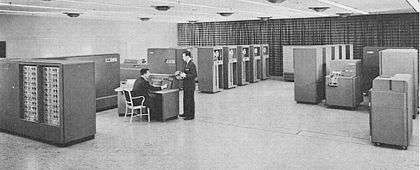IBM 702

The IBM 702 was IBM's response to the UNIVAC—the first mainframe computer using magnetic tapes. Because these machines had less computational power than the IBM 701 and ERA 1103, which were favored for scientific computing, the 702 was aimed at business computing.[1]
The system used electrostatic storage, consisting of 14, 28, 42, 56, or 70 Williams tubes with a capacity of 1000 bits each for the main memory, giving a memory of 2,000 to 10,000 characters of seven bits each (in increments of 2,000 characters), and 14 Williams tubes with a capacity of 512 bits each for the two 512-character accumulators.
A complete system included the following units:
- IBM 702 Central Processing Unit
- IBM 712 Card Reader
- IBM 756 Card Reader Control Unit
- IBM 717 Printer
- IBM 757 Printer Control Unit
- IBM 722 Card Punch
- IBM 758 Card Punch Control Unit
- IBM 727 Magnetic Tape Unit
- IBM 752 Tape Control Unit
- IBM 732 Magnetic Drum Storage Unit
The 702 was announced September 25, 1953 and withdrawn October 1, 1954, but the first production model was not installed until July 1955.[2] The successor to the 702 in the 700/7000 series was the IBM 705, which marked the transition to magnetic core memory.[1]
Fourteen 702s were built. The first one was used at IBM. Due to problems with the Williams tubes, the decision was made to switch to magnetic core memory instead. The fourteenth 702 was built using magnetic core memory and the others were retrofitted with magnetic core.[2]
See also
References
- 1 2 Emerson W. Pugh, Lyle R. Johnson, John H. Palmer, IBM's 360 and early 370 systems, MIT Press, 1991, ISBN 0-262-16123-0 pp. 26-27
- 1 2 Charles J. Bashe, Lyle R. Johnson, John H. Palmer, & Emerson W. Pugh, IBM's Early Computers, MIT Press, 1986, ISBN 0-262-02225-7 pp. 176-178
External links
- IBM Archives: 702 Data Processing System
- IBM 702 Documents on bitsavers
- The Williams Tube
- IBM 702 photos